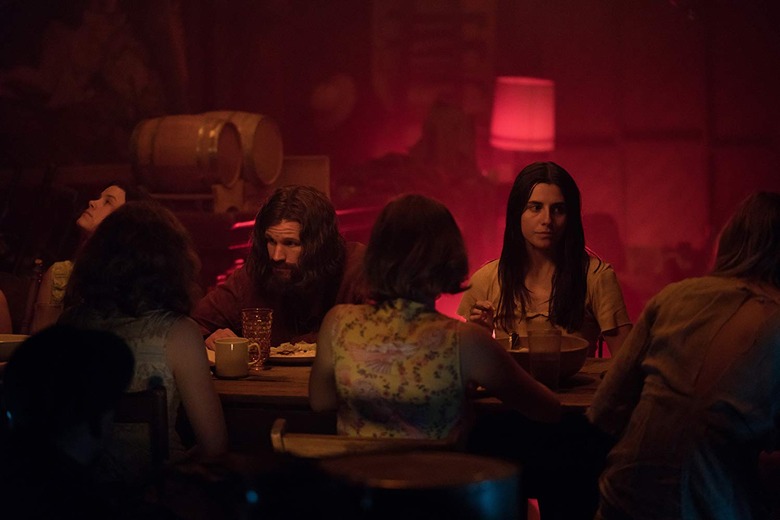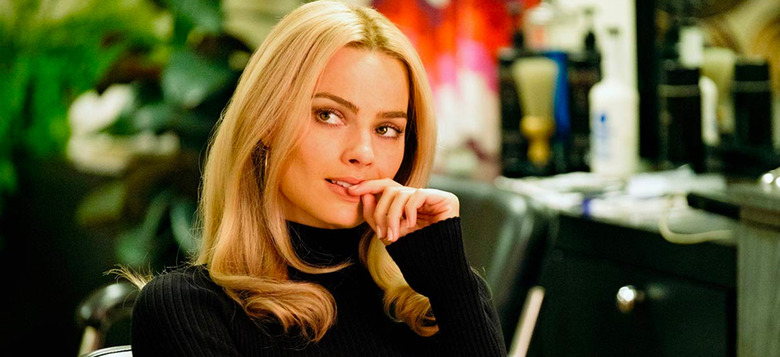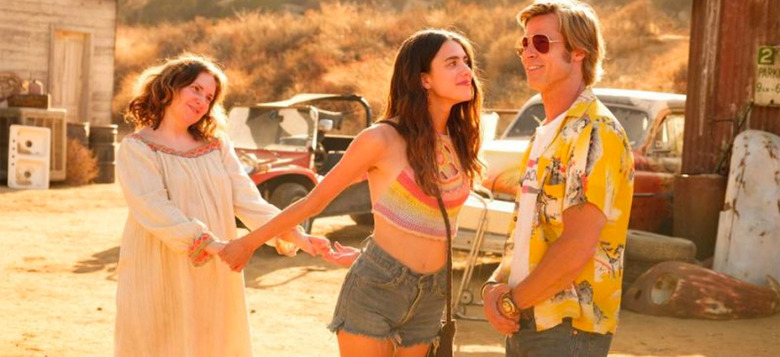'Once Upon A Time In Hollywood' And 'Charlie Says' Paint Very Different, But Equally Necessary, Portraits Of The Manson Family
It's almost easy for modern audiences to forget just how tumultuous the 1960s were. In 1963, Civil Rights leader Medgar Evers was assassinated in the driveway of his own home. Months later, a bomb planted in Birmingham's 16th Street Baptist Church killed four young girls. That November, the President of the United States was assassinated in front of hundreds of people while driving through Dallas. Fast forward to February 1965, when Malcolm X was assassinated at the Audubon Ballroom. One month later, peaceful protesters marching for voting rights were violently attacked on the Edmund Pettus Bridge on "Blood Sunday." In 1968, Dr. Martin Luther King, Jr. and Robert F. Kennedy were assassinated just one month apart. All the while, Vietnam raged, the body count climbing on both sides, scarring both the Southeast Asian landscape and the men who returned home broken in both mind and body. These are just some of the "highlights." There was a revolution in the streets and a revolution in the sheets. A generation disenchanted by the American Dream, eschewed "traditional" values, dabbled in drugs, grew out their hair, and espoused free love ideals. But the advent of television meant being unable to feign ignorance at the bodies piling up overseas and in segregated cities at home. And so, turn on, tune in, drop out. But underneath it all, violence always simmered. In 1969, it finally boiled over. The legacy of Charles Manson has always loomed over Hollywood, weaving an insidious web that made glitz and glamour unwitting allies with brutal murder. With the 50th anniversary of the Manson Murders looming this coming August, it was inevitable that Hollywood would become introspective and sort through the tea leaves once more to try and decipher just who left the back door open wide enough for evil to slip inside.Those attempts, in part, come in the form of two films, Charlie Says, from American Psycho director Mary Harron, and Quentin Tarantino's highly-anticipated Once Upon a Time...in Hollywood. (A third Manson-centered film, The Haunting of Sharon Tate, grossly suggests Tate had premonitions of the murders, indirectly placing blame on her, and won't be discussed here.) Although the two films take drastically different approaches to Manson and his followers, both offer vital answers to the myriad of questions we've puzzled over in the aftermath of August 1969.
Charlie Says
In Charlie Says, Harron introduces the audience to three of the Manson Girls, Leslie Van Houten (Hannah Murray), Patricia Krenwinkle (Sosia Bacon), and Susan Atkins (Marianne Rendón) as they ponder their crimes and the path that led them to solitary confinement in California's Vacaville Women's Prison. In conversations with the women, graduate student Karlene Faith (Merritt Weaver) comes to view the women as victims in their own right, although many of her colleagues do not agree. When Manson and his followers were formally charged with the Tate-LaBianca murders in 1970s, plenty of Americans were both shocked and puzzled to discover that seemingly ordinary young women had committed such brutal acts of violence. How could this be possible? It's a question Harron strives to answer in Charlie Says, and she does so through numerous flashbacks from Van Houten's introduction to The Family, through her indoctrination and Manson's own failed dreams of stardom, ultimately culminating in violence.From the offset, The Family seem interesting enough. The sprawling Spahn Ranch offers both shelter, seclusion, and stunning views. The Family are a close-knit bunch who dumpster dive for meals, raise each other's children, and take care of one another. And then there's Charlie. A far cry from his beloved and spunky Eleventh Doctor, Matt Smith is able to channel that familiar charisma into a compelling performance as the slick-talking Manson, who is able to balance between being warm and inviting and alternately sadistic and cruel. On Van Houten's first night with the group, Charlie entices the women to embrace one of their fellow family members, a shy young woman who can't stop sobbing during Charlie's feelgood speeches about empowerment and love. He demands the woman strip naked in front of the entire group, and then commands everyone to come up and embrace her, telling her that she is beautiful.But while there's a hint of authority in his voice, Charlie is compelling the women to act out of love. As the women, coo and dote on the girl, Charlie looks into her eyes and tells her firmly that there is nothing wrong with her, that her parents were the defective ones. In the soft glow of the campfire light, the audience sees the jagged trail of a scoliosis scar clawing down the young woman's back. By espousing body positivity and reinforcing it with group love, Charlie is able to build back the young woman's self-esteem and, in turn, solder his own wisdom and authority as the source of that empowerment. These young women, many of them runaways from broken homes who always felt out of place, can feel good about themselves for possibly the first time ever, but only so long as Charlie (and in turn, The Family) thinks so.In a later scene, as The Family bunk up for the night and begin descending into a drug-fueled orgy, Charlie lightly berates Tex Watson (Chace Crawford) for being unable to orally please the women. Their pleasure is just as important as his, Charlie declares, before making Tex perform oral sex on his partner in front of the entire Family, while he offers instructions. Here, in spouting sex positivity and sexual equality, Manson aligns himself with the dominant counterculture of the time, reinforcing the idea that whatever he says must be right. It's an absolute trust that's slowly but skillfully built, layer by layer, so that when Manson begins deviating from this, it's accepted without question. As mirrored in the film's title, it has to be okay because, after all, Charlie says so. With these scenes, the adoration the three Manson women display for Charlie starts to shift more clearly into focus. Charlie hasn't just given them a home, a place where they can feel included and important, but he's invested in their self-esteem. He gives the women nicknames, Susan becomes Sadie, Patricia is renamed Katie, and Leslie is rechristened Lulu. They now have a new identity, a new family, a new life and purpose, thanks to Charlie. To her credit, Harron never absolves the Manson girls of the Tate-LaBianca Murders. Instead, the film's exploration of their own victimhood serves more as motive than as an excuse. The women absolutely believed that, per Charlie's prophecies, that Helter Skelter, the ultimate race war, would break out soon and The Family would survive and thrive thanks to Charlie's shepherding. In a decade filled with assassinations, racial unrest and riots, college students being gunned down on campus, and bloody clashes between police and protesters, the idea of the country erupting into an even larger war wasn't that hard to imagine. And so, if the person you truly loved, who had given you so much, asked you to commit a crime to help facilitate your chances of survival, you would say yes without hesitation. It is only months later, separated from Charlie and entombed inside of the walls of Vacaville that the women realize how ridiculous it all sounds when spoken out loud. And it is only then that the gravity of their crimes, the true horror and grief and weight of them, dawns on them. Charlie lied.
Once Upon a Time in Hollywood
While Manson takes centerstage in much of Charlie Says, Sharon Tate is mostly absent apart from a scene mirrored in Once Upon a Time...in Hollywood, which establishes that Manson knew that Terry Melcher, the record producer who spurned his dreams of music stardom, had left Cielo Drive for another residence. It was the crucial link that, as prosecutor Vincent Bugliosi explains in his 1974 recollection of the trials, Helter Skelter, was needed to convict Manson of the murders. The Family supplied the manpower, while Charlie supplied the motive. By including similar scenes in which Manson discovers Tate living at 10050 Cielo Drive, both Harron and Tarantino make it abundantly clear who is responsible for her fate: Charles Manson. In Once Upon a Time...in Hollywood, this is the only time we see Manson. Instead, Tarantino chooses to spend screentime exploring a different but important question: Just who was Sharon Tate? On the surface, it seems like an obvious answer, but the answers are often reductive. In the lasting legacy of the Manson Murders, Tate is often known as two things: murder victim and Roman Polanski's pregnant wife. But Tate was so much more, and Tarantino celebrates her life by spending the majority of time showing Tate doing mundane but still important things. Here's Sharon at home packing a suitcase while blasting Paul Revere & the Raiders. A mini-skirt clad Sharon picks up a used book for her husband before sneaking into a midday screening of her latest film, The Wrecking Crew, and marveling at the bemused reactions from the crowd to her on-screen antics. Later, a pregnant Sharon gets to show off the nursery to a female friend. She goes out to dinner on August 9 with her friends and is happily surprised to discover that yes, dirty movies also have film premieres. The Hollywood glamor is there, to be sure, as Tate happily dances around the Playboy Mansion, hobnobbing with starlets of yesteryear, or struts out of LAX clad in luscious furs and big sunglasses, flashbulbs christening her every step as worthy of documentation. Too often lost in the shuffle of her untimely death is the reality that Tate's star was firmly on the rise. She was ready for her close-up, and Tarantino aims to finally give it to her. Tarantino even seeks to reclaim some of the spaces made infamous by the murders. The white Dutch front door where the word "PIG" was scrawled in blood is instead seen firmly closing shut on a retreating and rebuked Charles Manson. The backyard where Abigail Folger tried in vain to escape from Patricia Krenwinkel is instead the scene where a hungover Roman Polanski plops down with a fresh pot of coffee and grumpily plays with his dog.In giving life and space back to Sharon Tate, Once Upon a Time...in Hollywood doesn't pull any punches when it comes to the Manson Family, taking a decidedly less sympathetic approach than Harron's film. Although Rick Dalton turns up his nose at the hippies who dumpster dive and hitchhike around Los Angeles, it isn't until Cliff Booth arrives at Spahn Ranch that we see the seedier and more sinister side of The Family. Here, women lurk in the shadows, lazily watching Booth walk around the dilapidated movie set, scurrying off to whisper to other members who begin to gather like flies. Up at the Spahn house, Squeaky flatly tells Booth that the older man is napping, which despite Booth's understandable uncertainly winds up being true. But he isn't being taken care of in a dignified way, either. The house is filthy and used in part as a common room for the other Family members to smoke weed and watch TV. Squeaky "fucked his brains out" earlier that morning, and plans to watch TV with him that night. She doesn't hurt him, but she doesn't love him either. As Booth says, the truth is a lot more complicated.
A Tale of Two Families
Perhaps lost in the shuffle of Charlie Says but certainly vividly present in Once Upon a Time...in Hollywood is the truth that The Family were grifters, constantly seeking souls to pull into the fold and indoctrinate, even when Manson wasn't physically present. "Charlie's really gonna dig you," Pussycat keeps telling Booth upon his initial arrival. And why is that exactly? Perhaps because, like Dennis Wilson before him, Booth comes complete with a fancy car and Hollywood connections that Manson would find useful. Tarantino isn't interested in unpacking the reasons for their indoctrination, valid as they might be. Instead, Manson's women are just as shifty and untrustworthy as he is. Even if accepted into the fold, you need to sleep with one eye open. Both Once Upon a Time...in Hollywood and Charlie Says are essential viewing to try and unpack the puzzle of how and why the promise of the 60s came to such an abrupt over two nights in August 50 years ago. The truth, however, lies somewhere in the middle; the shadowy area where two things can be true at once, a place which always causes a sense of unease in the pit of our stomachs.It's easy to look at the carnage left behind by the Manson Family and feel nothing but rage. How can Susan Atkins, who infamously told a pleading Sharon Tate "I have no mercy for you" also have been a victim in her own right? Does ascribing victimhood strip her of her complicity of the crimes she committed? In Tarantino's eyes, it does, and he treats Atkins with supreme irreverence, viciously breaking her nose and teeth, turning her into a screaming ghoul before toasting her to a crisp with Rick's flamethrower for good measure. Harron, instead, focuses on Atkins' penitential reform in prison, where she discovered and immersed herself in Christianity, seemingly trading one fanatical devotion for another. Charlie Says reminds us that Manson Family remain a cautionary tale of complexity, reminding us how our quest for identity can sometimes find us stumbling down the darkest paths, ones that rot us from within. Victimhood can take many shapes and faces, and while we should find compassion for all, it is also time for Tate's legacy to shine more brightly than ever. And this is the enduring promise of Once Upon a Time...in Hollywood, which reminds us that no matter the length of time we are given, we can touch the people around us with love that can truly endure. And that's worth remembering.



